The Wheelchair Guide
Your Wheelchair and Mobility Scooter Resource
Choosing the Right Type of Mobility Vehicle Lift
Saturday, December 5th, 2009
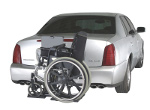 Vehicle Lifts are used to make it easier to transport a wheelchair or mobility scooter. When considering what type of vehicle lift to use, there are several factors that should be taken into account, including what type of mobility vehicle is being transported and what type of vehicle is being used. These factors will often help narrow down the options that are available to the wheelchair user, making it much simpler to select the right wheelchair lift.
Vehicle Lifts are used to make it easier to transport a wheelchair or mobility scooter. When considering what type of vehicle lift to use, there are several factors that should be taken into account, including what type of mobility vehicle is being transported and what type of vehicle is being used. These factors will often help narrow down the options that are available to the wheelchair user, making it much simpler to select the right wheelchair lift.
What Type of Mobility Vehicle is Being Transported
The type of mobility vehicle that is being transported is often the biggest factor that helps determine what type of vehicle lift to use. There are many different models of mobility vehicles, but they can usually be classified as manual wheelchairs, electric wheelchairs, and mobility scooters.
In the case of transporting a manual wheelchair, most people will simply fold it up and put it in their trunk. However, since manual wheelchairs can be rather heavy, sometimes lifting them into the back of the car can be difficult. Also, there is often simply not enough room in the car, so an external wheelchair lift is used. These are usually not motorized and attach to the hitch of a vehicle.
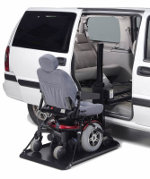 Of course, if you have a mobility scooter or an electric wheelchair, a manual wheelchair lift will not work. Instead, you would need to invest in a motorized wheelchair lift. In some cases, electric wheelchair carriers and mobility scooters carriers can be used interchangeably, but this is not always the case.
Of course, if you have a mobility scooter or an electric wheelchair, a manual wheelchair lift will not work. Instead, you would need to invest in a motorized wheelchair lift. In some cases, electric wheelchair carriers and mobility scooters carriers can be used interchangeably, but this is not always the case.
For example, often instead of a full platform, mobility scooter lifts will use a lift that has metal tracks, which are only large enough for the wheels of the scooter to fit into. When loading the scooter, the wheels will be driven into the tracks, which support the entire weight of the device. For three wheel scooters, the lift will have three tracks and for four wheeled scooters, there would be two tracks.
Some other lifts will have automatic hold down arms, which engage as the lift is being raised and hold the scooter in place without the need for tie-down straps. The automatic hold down arm works, because of the longer design of the mobility scooter, making contact with the floor portion where the use rests their feet. However, most electric wheelchairs will not work with this type of lift.
When in doubt, if the lift is labeled as an Universal Lift this means it will work with both electric wheelchairs and mobility scooters. Otherwise, it will often only work with one or the other.
What Type of Vehicle is Doing the Transporting
 The type of vehicle that will transporting the mobility vehicle is also important.
The type of vehicle that will transporting the mobility vehicle is also important.
For example, those that wished to use a passenger car have fewer options than those with a van or SUV. Typically, the only option would be a hitch mounted lift or a crane lift. The hitch mounted lift is simply inserted onto the vehicles hitch and either has its own battery pack or uses the vehicles power. Crane lifts are installed into the trunk of the car and simply hoist the wheelchair off the ground in the same manner a crane lifts a heavy load to the top of a building. One feature to look out for when shopping for crane lifts is Powered Rotation, which means the crane’s arm can be completely controlled electronically.
Those who have a SUV or van can also use the hitch mounted lift or the crane lift, but internal wheelchair lifts are also an option. These use a small platform that extends from the vehicle, allows the scooter or wheelchair to be driven onto the platform, then retracts, storing the wheelchair inside of the vehicle. These are most popular with vans, as by removing one of the rows of seats, the scooter can be stored directly behind the drives seat. In SUVs, internal lifts are used in the rear trunk area.
Those with trucks also have a few options and can of course use the crane or hitch mounted options described above. There are also several specially made truck lifts that are designed to lift the scooter off of the ground and into the bed of the pickup truck.
Where You Live or Where You Plan on Traveling to
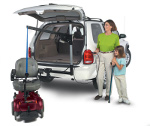 Yet another factor that helps determine what type of wheelchair lift is right, is where the person lives or where they plan on using the lift. For example, those who live in an area that gets a great deal of rain, snow, or other inclement weather, would probably want to go with a internal wheelchair lift. This way the wheelchair or scooter will be stored safely out of the weather.
Yet another factor that helps determine what type of wheelchair lift is right, is where the person lives or where they plan on using the lift. For example, those who live in an area that gets a great deal of rain, snow, or other inclement weather, would probably want to go with a internal wheelchair lift. This way the wheelchair or scooter will be stored safely out of the weather.
However, those who live in a more moderate climate would be able to use a hitch mounted wheelchair lift that stores the wheelchair outside of the vehicle. However, it is still usually recommended to invest in a cover for the wheelchair or scooter, to protect against sudden storms or road debris.
How to Transport a Wheelchair
Monday, November 2nd, 2009
As a result of the ADA and other legislation, many of the areas a wheelchair user wishes to go are made accessible. There are of course exceptions to the rule, but the overwhelming majority of businesses in the United States are wheelchair accessible. As a result, the most difficult part of using a wheelchair in public is generally getting it where you need it to be or transporting the wheelchair.
There are a number of different methods to transport a wheelchair, but often the most effective means is to use a vehicle wheelchair lift. Without a vehicle wheelchair lift, however, it is often still possible to transport a wheelchair.
Transporting the Wheelchair in the Trunk or Backseat
 Depending on the type of wheelchair, it is sometimes possible to simply store the wheelchair in the trunk of the vehicle or even in the back seat. This is easiest with manual wheelchairs, which are designed to be folded up when not in use.
Depending on the type of wheelchair, it is sometimes possible to simply store the wheelchair in the trunk of the vehicle or even in the back seat. This is easiest with manual wheelchairs, which are designed to be folded up when not in use.
Some electric wheelchairs and mobility scooters are also designed to be transported easily without a wheelchair lift. These mobility vehicles are usually called travel wheelchairs or travel scooters and are made to be taken apart easily, with no one piece weighing too much for a person to safely lift into their trunk. One drawback to this type of electric power chair or scooter, however, is that in order to reduce weight, a number of features are removed that are in other standard electric wheelchairs.
Using a Van Ramp
 Another option for transporting a wheelchair is to use a ramp system. There are a number of metal folding ramps available, which are designed to be used with the side door of a van. These allow the wheelchair to be driven directly into the van or to be operated by someone standing next to the wheelchair.
Another option for transporting a wheelchair is to use a ramp system. There are a number of metal folding ramps available, which are designed to be used with the side door of a van. These allow the wheelchair to be driven directly into the van or to be operated by someone standing next to the wheelchair.
While it is possible to use a ramp with other types of vehicles, this option works best with vans that have had at least one row of seats removed.
Ramps offer a cost effective wheelchair transport solution, but do not work with all vehicles and unless someone is there to help position the ramp, they can be difficult to use.
Using a Wheelchair Lift
Wheelchair lifts are more expensive than using a ramp, but are much easier to use independently. There are a number of wheelchair lift designs, but they can be broken down into interior wheelchair lifts and exterior wheelchair lift.
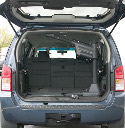 Interior wheelchair lifts are installed inside of the vehicle and store the wheelchair inside as well. There are a few different designs, but most either use a platform lift system or a crane lift system. The platform lift system allows the user to drive their wheelchair onto a small platform that extends from the vehicle. Then, once activated, the wheelchair lift will move the platform and wheelchair inside of the vehicle. You will often see this type of wheelchair lift in vans, but they can also be used in trucks and SUVs.
Interior wheelchair lifts are installed inside of the vehicle and store the wheelchair inside as well. There are a few different designs, but most either use a platform lift system or a crane lift system. The platform lift system allows the user to drive their wheelchair onto a small platform that extends from the vehicle. Then, once activated, the wheelchair lift will move the platform and wheelchair inside of the vehicle. You will often see this type of wheelchair lift in vans, but they can also be used in trucks and SUVs.
The other type of interior wheelchair lift is the crane lift, which is basically just a crane that attaches to the wheelchair and the raises it into the vehicle. Crane lifts can not be used with someone sitting on the wheelchair and it is sometimes necessary to partially disassemble the wheelchair before moving it into the vehicle.
One of the advantages of crane lifts is that they don’t take up much space, so they can be used in a car, where other wheelchair lifts would not work. A nice feature when shopping for a crane wheelchair lift is powered rotation, which means that the arm of the crane can be swiveled using a hand control. This makes it easier to swing the wheelchair into position.
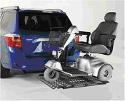 Exterior wheelchair lifts, on the other hand, almost always use a platform lift system, except unlike interior wheelchair lift, the wheelchair is stored outside of the vehicle. Exterior wheelchair lifts attach to the hitch of a vehicle, which means that they are very easy to install, don’t require modification to the vehicle, and do not take up any interior space.
Exterior wheelchair lifts, on the other hand, almost always use a platform lift system, except unlike interior wheelchair lift, the wheelchair is stored outside of the vehicle. Exterior wheelchair lifts attach to the hitch of a vehicle, which means that they are very easy to install, don’t require modification to the vehicle, and do not take up any interior space.
A Look at Vehicle Wheelchair Lifts
Wednesday, August 19th, 2009
One of the most difficult aspects for many users of electric wheelchairs is figuring out how to safely and easily transport their mobility vehicle.
Often times, portable models are available, but most portable electric wheelchairs are lacking in features and functionality, in an effort to reduce weight. As a result, even though portable power chairs are often much easier to transport, they commonly lack the range, speed, and comfort that is offered by a full sized power chair. Fortunately, vehicle wheelchair lifts provide a easy and reliable way to transport most electric wheelchairs.
Hitch Mounted Wheelchair Lifts
The Hitch Mounted Wheelchair Lift is the easiest type of wheelchair lift to install or remove. All it requires is a square hitch installed on the vehicle. Most vehicle wheelchair lifts require at least a Class II hitch and to get the full weight capacity of the lift, a Class III hitch.
To install a hitch mounted wheelchair lift, it is simply slid into the square hitch and secured with a pin. For electrical models without their own battery pack, most can simply be plugged into the vehicles trailer light plug.
There are actually several different types of hitch mounted wheelchair lifts available, but most use an electrical lifting platform, which lowers to the ground and allows the wheelchair to be driven onto. The platform is then raised and the power chair secured. Some include an automatic lockdown arm, which holds the wheelchair in place as the wheelchair lift rises. Other require that the user strap down the power chair.
There are also tilting models available that use no power at all, which are popular for lighter electric wheelchairs.
The major advantage of a hitch mounted wheelchair lift is that it can be installed in only a few minutes without any modification to the vehicle. Subsequently, it can be removed just as easily.
Crane Wheelchair Lifts
Crane Wheelchair Lifts operate similar to a crane on a construction site. A harness is attached to the wheelchair, which is then hoisted off of the ground and moved into the vehicle by the crane lift. Often, crane lifts are installed into the trunk of a car or other area with minimal space. In these cases, the seat of the wheelchair will typically have to be removed before raising the wheelchair off of the ground.
There are also hitch mounted crane lifts available, which are especially popular on trucks, as they can quickly and easily move a wheelchair into the bed of a pickup truck and do not require any permanent installation.
When investing in a crane wheelchair lift, it is a good idea to go with one that has powered rotation. Powered rotation means that the cranes boom can be operated with a remote control, so swinging the wheelchair into the vehicle does not require any more effort than pushing a button.
Internal Wheelchair Lifts
Internal wheelchair lifts are very popular and use an electric platform to extend a platform from the vehicle. The wheelchair is driven onto the platform, which then lifts the wheelchair and stores it inside of the vehicle.
Internal wheelchair lifts are probably most recognized as van lifts, which are installed in the passenger compartment of a van, after a row of seats has been removed. However, they can also be installed into the trunk of an SUV or Van.
One of the major advantages of using an internal wheelchair lift is that the wheelchair is stored inside the vehicle, away from the elements. Of course, this comes at the cost of lost space. For those who drive themselves around, a van wheelchair lift can make transferring into and out of the drive seat much easier though.
Internal wheelchair lifts require a more permanent installation than other types of wheelchair lifts.
Vehicle Mobility Scooter Lifts
For mobility scooter users, vehicle scooter carriers are available that are similar to those described above. In fact, there are a number of universal vehicle wheelchair lifts that can be used with both electric wheelchairs and mobility scooters. However, there are also some that will only work with wheelchairs or scooters. For mobility scooter users, it is important to know how many wheels the mobility scooter has, either three or four, as this is one of the most important factors when determining if a wheelchair lift will work with a mobility scooter.
Vehicle Wheelchair Lifts
Saturday, August 15th, 2009
Wheelchairs and mobility scooters are very important mobility vehicles used by millions all over the World. Since many people do not only stay at home, it is typically necessary to find a means of transporting these types of mobility vehicles in your car or truck.
One option is to simply place the mobility vehicle in the trunk or back seat of the automobile. This is of course not possible with large electric wheelchairs and mobility scooters, but it is often a choice when dealing with manual wheelchairs, travel wheelchairs, and travel scooters. However, in the case of the latter two, many features have been removed to make these devices lightweight and easy to disassemble, so for everyday use, a travel scooter and portable wheelchair is often not preferable.
Wheelchair Lifts
Using a wheelchair lift, on the other hand, allows the mobility vehicle to be transported in a car, truck, SUV, or van without having to disassemble the wheelchair or scooter. There are different types of wheelchair lifts available for the three basic types of mobility vehicles; mobility scooters, electric wheelchairs, and manual wheelchairs, but they operate similarly.
 One of the most common types of vehicle wheelchair lifts available is the hitch mounted wheelchair lift. These are popular because they can be slid into a standard square hitch and installed with little or no actual modification to the vehicle. The Class of the hitch, either Class I, II, or III, is important though, as this is a factor that affects how much weight the wheelchair lift can support.
One of the most common types of vehicle wheelchair lifts available is the hitch mounted wheelchair lift. These are popular because they can be slid into a standard square hitch and installed with little or no actual modification to the vehicle. The Class of the hitch, either Class I, II, or III, is important though, as this is a factor that affects how much weight the wheelchair lift can support.
Usually a hitch mounted wheelchair lift will provide an electronically powered lifting platform that the wheelchair can be driven onto and then automatically raised. Often, as an accessory a swing away arm is available, that allows the wheelchair platform to be swung away so the trunk area of the automobile can be accessed. There are also un-powered models available, which are popular for manual wheelchairs, that use a tilting system.
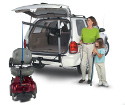 Another type of vehicle wheelchair lift, which is very popular in cars, is the crane wheelchair lift. Crane lifts can be installed in the trunk of a car and swivel away from the vehicle. A harness is attached to the wheelchair, which is subsequently raised and moved into the trunk.
Another type of vehicle wheelchair lift, which is very popular in cars, is the crane wheelchair lift. Crane lifts can be installed in the trunk of a car and swivel away from the vehicle. A harness is attached to the wheelchair, which is subsequently raised and moved into the trunk.
One thing to consider when using a crane lift is whether or not it has powered rotation. Powered rotation means that instead of having to push the cranes arm and wheelchair into and away from the trunk, you can simply push a button and it will swivel electronically.
Usually crane lifts require that the seat of the wheelchair be removed to save space if it is being used in the trunk of a passenger car. There are also hitch mounted crane lifts available, which are popular for use with trunks or extremely limited trunk space.
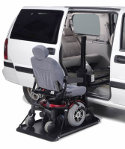 The other type of vehicle wheelchair lift is the internal platform lift. These are installed inside of a vehicle, often in place of a row of seats in a van or in the back of an SUV. The platform extends from the vehicle, allowing the wheelchair to be driven onto the platform, which then retracts storing the wheelchair inside of the vehicle. These wheelchair lifts are popular because the store the wheelchair safely inside the vehicle, however they require a more permanent installation and can take up a great deal of internal vehicle space.
The other type of vehicle wheelchair lift is the internal platform lift. These are installed inside of a vehicle, often in place of a row of seats in a van or in the back of an SUV. The platform extends from the vehicle, allowing the wheelchair to be driven onto the platform, which then retracts storing the wheelchair inside of the vehicle. These wheelchair lifts are popular because the store the wheelchair safely inside the vehicle, however they require a more permanent installation and can take up a great deal of internal vehicle space.